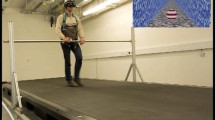Abstract
One of the fundamental requirements for successful navigation through an environment is the continuous monitoring of distance travelled. To do so, humans normally use one or a combination of visual, proprioceptive/efferent, vestibular, and temporal cues. In the real world, information from one sensory modality is normally congruent with information from other modalities; hence, studying the nature of sensory interactions is often difficult. In order to decouple the natural covariation between different sensory cues, we used virtual reality technology to vary the relation between the information generated from visual sources and the information generated from proprioceptive/efferent sources. When we manipulated the stimuli such that the visual information was coupled in various ways to the proprioceptive/efferent information, human subjects predominantly used visual information to estimate the ratio of two traversed path lengths. Although proprioceptive/efferent information was not used directly, the mere availability of proprioceptive information increased the accuracy of relative path length estimation based on visual cues, even though the proprioceptive/efferent information was inconsistent with the visual information. These results convincingly demonstrated that active movement (locomotion) facilitates visual perception of path length travelled.









Similar content being viewed by others
References
Bigel MG, Ellard CG (2000) The contribution of nonvisual information to simple place navigation and distance estimation: an examination of path integration. Can J Exp Psychol 54:172–185
Bremmer F, Lappe M (1999) The use of optical velocities for distance discrimination and reproduction during visually simulated self motion. Exp Brain Res 127:33–42
Chance SS, Gaunet F, Beall AC, Loomis JM (1998) Locomotion mode affects the updating of objects encountered during travel: the contribution of vestibular and proprioceptive inputs to path integration. Presence-Teleop Virt Env 7:168–178
Clark JJ, Yuille AL (1990) Data fusion for sensory information processing systems. Kluwer Academic Publishers, Boston
Elliott D (1986) Continuous visual information may be important after all: a failure to replicate Thomson (1983). J Exp Psychol Hum Percept Perform 12:388–391
Ernst MO, Banks MS (2002) Humans integrate visual and haptic information in a statistically optimal fashion. Nature 415:429–433
Foos PW (1982) Distance estimation and information load. Percept Mot Skills 54(1):79–82
Gibson JJ (1950) The perception of the visual world. Houghton Mifflin, Boston
Grant SC, Magee LE (1998) Contributions of proprioception to navigation in virtual environments. Hum Factors 40(3):489–497
Harman KL, Humphrey GK, Goodale MA (1999) Active manual control of object views facilitates visual recognition. Curr Biol 22:1315–1318
Harris LR, Jenkin M, Zikovitz DC (2000) Visual and non-visual cues in the perception of linear self motion. Exp Brain Res 135:12–21
Johnston EB, Cumming BG, Parker AJ (1993) Integration of depth modules: stereopsis and texture. Vision Res 33:813–826
Johnston EB, Cumming BG, Landy MS (1994) Integration of stereopsis and motion shape cues. Vision Res 34:2259–2275
Kearns MJ, Warren WH, Duchon AP, Tarr MJ (2002) Path integration from optic flow and body senses in a homing task. Perception 31:349–374
Klatzky RL, Loomis JM, Beall AC, Chance SS, and Golledge RG (1998) Spatial updating of self-position and orientation during real, imagined, and virtual locomotion. Psychol Sci 9:293–298
Konczak J (1994) Effects of optic flow on the kinematics of human gait: a comparison of young and older adults. J Mot Behav 26:225–36
Lambrey S, Viaud-Delmon I, Berthoz A (2002) Influence of a sensorimotor conflict on the memorization of a path traveled in virtual reality. Cog Brain Res 14:177–186
Lee DN (1980) The optic flow field: the foundation of vision. Philos Trans R Soc Lond B Biol Sci 290:169–179
Loomis JM, Da Silva JA, Fujita N, Fukusima SS (1992) Visual space perception and visually directed action. J Exp Psychol Hum Percept Perform 18:906–921
Mergner T, Rosemeier T (1998) Interaction of vestibular, somatosensory and visual signals for postural control and motion perception under terrestrial and microgravity conditions—a conceptual model. Brain Res Brain Res Rev 28:118–135
Milner AD, Goodale MA (1996) The visual brain in action. Oxford University Press, Oxford
Mittelstaedt ML, Mittelstaedt H (2001) Idiothetic navigation in humans: estimation of path length. Exp Brain Res 139:318–332
Ohmi M (1996) Egocentric perception through interaction among many sensory systems. Cog Brain Res 5:87–96
Pick HL Jr, Warren DH, Hay JC (1969) Sensory conflict in judgments of spatial direction. Percept Psychophys 6:203–205
Prokop T, Schubert M, Berger W (1997) Visual influence on human locomotion. Exp Brain Res 114:63–70
Redlick FP, Jenkin M, Harris LR (2001) Humans can use optic flow to estimate distance of travel. Vision Res 41:213–219
Regan D, Hamstra SJ (1993) Dissociation of discrimination thresholds for time to contact and for rate of angular expansion. Vision Res 33:447–462
Rieser JJ, Ashmead DH, Talor CR, Youngquist GA (1990) Visual perception and the guidance of locomotion without vision to previously seen targets. Perception 19:675–689
Rieser JJ, Pick HL, Ashmead DH, Garing AE (1995) Calibration of human locomotion and models of perceptual-motor organization. J Exp Psychol Hum Percept Perform 21:480–497
Sadalla EK, Magel SG (1980) The perception of traversed distance. Environ Behav 12(1):65–79
Simons DJ, Wang RF (1998) Perceiving real-world viewpoint changes. Psychol Sci 9:315–320
Stappers PJ (1996) Matching proprioceptive to visual speed affected by nonkinematic parameters. Percept Mot Skills 83:1353–4
Steenhuis RE, Goodale MA (1988) The effects of time and distance on accuracy of target-directed locomotion: does an accurate short-term memory for spatial location exist? J Mot Behav 20:399–415
Sun H-J, Frost BJ (1998) Computation of different optical variables of looming objects in pigeon nucleus rotundus neurons. Nat Neurosci 1:296–303
Sun H-J, Carey DP, Goodale MA (1992) A mammalian model of optic-flow utilization in the control of locomotion. Exp Brain Res 91:171–175
Thomson JA (1983) Is continuous visual monitoring necessary in visually guided locomotion? J Exp Psychol Hum Percept Perform 9:427–443
van Beers RJ, Sittig AC, van der Gon JJD (1999) Integration of proprioceptive and visual position-information: an experimentally supported model. J Neurophysiol 81:1355–1364
van Beers RJ, Wolpert DM, Haggard P (2002). When feeling is more important than seeing in sensorimotor adaptation. Curr Biol 12:834–837
Varraine E, Bonnard M, Pailhous J (2002) Interaction between different sensory cues in the control of human gait. Exp Brain Res 142:374–384
Warren DH (1979) Spatial localization under conflict conditions: is there a single explanation? Perception 8:323–337
Warren WH, Hannon DJ (1990) Eye movements and optical flow. Journal of the J Opt Soc Am A 7:160–169
Warren DH, Rossano MJ (1991) Intermodality relations vision and touch. In: Heller MA, Schiff W (eds) The psychology of touch. Erlbaum, Hillsdale, NJ, pp119–137
Welch RB (1978) Perceptual modification. Academic Press, New York
Welch RB, Warren DH (1986) Intersensory interactions. In: Boff KR, Kaufman L, Thomas JP (eds) Handbook of perception and human performance. Wiley, New York, pp 25.1–25.36
Witmer BG, Kline PB (1998) Judging perceived and traversed distance in virtual environments. Presence-Teleop Virt Env 7:144–167
Young MJ, Landy MS, Maloney LT (1993) A perturbation analysis of depth perception from combinations of texture and motion cues. Vision Res 33:2685–2696
Zar JH (1996) Biostatistical analysis, 3rd edn. Prentice-Hall, New Jersey, pp 353–357
Acknowledgements
The authors wish to thank Drs. D. Maurer, R. Racine, L. Allan, and C. Ellard for helpful discussions and comments on the manuscript and N. Jones, K. Strode, and D. Zelek for their assistance in collecting data. We would also like to thank Dr. B. Frost, G. Barrett, and R. Dupras for discussions and assistance in the initial design and construction of the VR interface and software. We also thank two anonymous reviewers for helpful comments on the earlier versions of this article. This work was supported by grants from the Natural Science and Engineering Research Council of Canada and the Canadian Foundation for Innovation to H.-J.S.
Author information
Authors and Affiliations
Corresponding author
Rights and permissions
About this article
Cite this article
Sun, HJ., Campos, J.L. & Chan, G.S.W. Multisensory integration in the estimation of relative path length. Exp Brain Res 154, 246–254 (2004). https://doi.org/10.1007/s00221-003-1652-9
Received:
Accepted:
Published:
Issue Date:
DOI: https://doi.org/10.1007/s00221-003-1652-9




